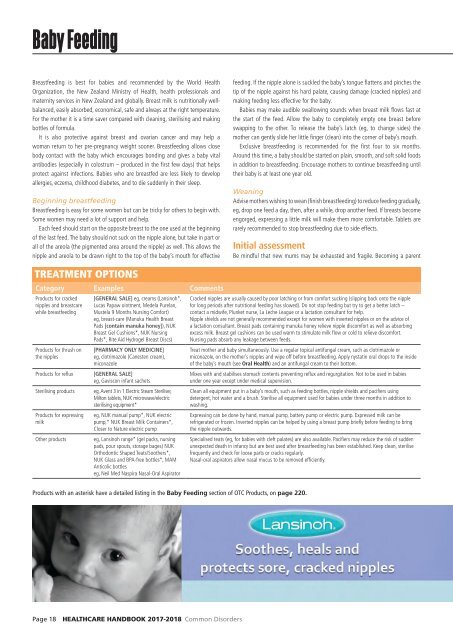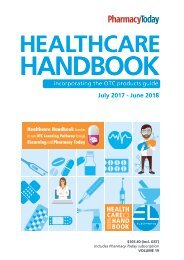2017 HCHB_digital
Create successful ePaper yourself
Turn your PDF publications into a flip-book with our unique Google optimized e-Paper software.
Baby Feeding<br />
Breastfeeding is best for babies and recommended by the World Health<br />
Organization, the New Zealand Ministry of Health, health professionals and<br />
maternity services in New Zealand and globally. Breast milk is nutritionally wellbalanced,<br />
easily absorbed, economical, safe and always at the right temperature.<br />
For the mother it is a time saver compared with cleaning, sterilising and making<br />
bottles of formula.<br />
It is also protective against breast and ovarian cancer and may help a<br />
woman return to her pre-pregnancy weight sooner. Breastfeeding allows close<br />
body contact with the baby which encourages bonding and gives a baby vital<br />
antibodies (especially in colostrum – produced in the first few days) that helps<br />
protect against infections. Babies who are breastfed are less likely to develop<br />
allergies, eczema, childhood diabetes, and to die suddenly in their sleep.<br />
Beginning breastfeeding<br />
Breastfeeding is easy for some women but can be tricky for others to begin with.<br />
Some women may need a lot of support and help.<br />
Each feed should start on the opposite breast to the one used at the beginning<br />
of the last feed. The baby should not suck on the nipple alone, but take in part or<br />
all of the areola (the pigmented area around the nipple) as well. This allows the<br />
nipple and areola to be drawn right to the top of the baby’s mouth for effective<br />
feeding. If the nipple alone is suckled the baby’s tongue flattens and pinches the<br />
tip of the nipple against his hard palate, causing damage (cracked nipples) and<br />
making feeding less effective for the baby.<br />
Babies may make audible swallowing sounds when breast milk flows fast at<br />
the start of the feed. Allow the baby to completely empty one breast before<br />
swapping to the other. To release the baby’s latch (eg, to change sides) the<br />
mother can gently slide her little finger (clean) into the corner of baby’s mouth.<br />
Exclusive breastfeeding is recommended for the first four to six months.<br />
Around this time, a baby should be started on plain, smooth, and soft solid foods<br />
in addition to breastfeeding. Encourage mothers to continue breastfeeding until<br />
their baby is at least one year old.<br />
Weaning<br />
Advise mothers wishing to wean (finish breastfeeding) to reduce feeding gradually,<br />
eg, drop one feed a day, then, after a while, drop another feed. If breasts become<br />
engorged, expressing a little milk will make them more comfortable. Tablets are<br />
rarely recommended to stop breastfeeding due to side effects.<br />
Initial assessment<br />
Be mindful that new mums may be exhausted and fragile. Becoming a parent<br />
TREATMENT OPTIONS<br />
Category Examples Comments<br />
Products for cracked<br />
nipples and breastcare<br />
while breastfeeding<br />
Products for thrush on<br />
the nipples<br />
Products for reflux<br />
Sterilising products<br />
Products for expressing<br />
milk<br />
Other products<br />
[GENERAL SALE] eg, creams (Lansinoh*,<br />
Lucas Papaw ointment, Medela Purelan,<br />
Mustela 9 Months Nursing Comfort)<br />
eg, breast-care (Manuka Health Breast<br />
Pads [contain manuka honey]), NUK<br />
Breast Gel Cushions*, NUK Nursing<br />
Pads*, Rite Aid Hydrogel Breast Discs)<br />
[PHARMACY ONLY MEDICINE]<br />
eg, clotrimazole (Canesten cream),<br />
miconazole<br />
[GENERAL SALE]<br />
eg, Gaviscon infant sachets<br />
eg, Avent 3 in 1 Electric Steam Steriliser,<br />
Milton tablets, NUK microwave/electric<br />
sterilising equipment*<br />
eg, NUK manual pump*, NUK electric<br />
pump,* NUK Breast Milk Containers*,<br />
Closer to Nature electric pump<br />
eg, Lansinoh range* (gel packs, nursing<br />
pads, pour spouts, storage bages) NUK<br />
Orthodontic Shaped Teats/Soothers*,<br />
NUK Glass and BPA-free bottles*, MAM<br />
Anticolic bottles<br />
eg, Neil Med Naspira Nasal-Oral Aspirator<br />
Cracked nipples are usually caused by poor latching or from comfort sucking (slipping back onto the nipple<br />
for long periods after nutritional feeding has slowed). Do not stop feeding but try to get a better latch –<br />
contact a midwife, Plunket nurse, La Leche League or a lactation consultant for help.<br />
Nipple shields are not generally recommended except for women with inverted nipples or on the advice of<br />
a lactation consultant. Breast pads containing manuka honey relieve nipple discomfort as well as absorbing<br />
excess milk. Breast gel cushions can be used warm to stimulate milk flow or cold to relieve discomfort.<br />
Nursing pads absorb any leakage between feeds.<br />
Treat mother and baby simultaneously. Use a regular topical antifungal cream, such as clotrimazole or<br />
miconazole, on the mother’s nipples and wipe off before breastfeeding. Apply nystatin oral drops to the inside<br />
of the baby’s mouth (see Oral Health) and an antifungal cream to their bottom.<br />
Mixes with and stabilises stomach contents preventing reflux and regurgitation. Not to be used in babies<br />
under one year except under medical supervision.<br />
Clean all equipment put in a baby’s mouth, such as feeding bottles, nipple shields and pacifiers using<br />
detergent, hot water and a brush. Sterilise all equipment used for babies under three months in addition to<br />
washing.<br />
Expressing can be done by hand, manual pump, battery pump or electric pump. Expressed milk can be<br />
refrigerated or frozen. Inverted nipples can be helped by using a breast pump briefly before feeding to bring<br />
the nipple outwards.<br />
Specialised teats (eg, for babies with cleft palates) are also available. Pacifiers may reduce the risk of sudden<br />
unexpected death in infancy but are best used after breastfeeding has been established. Keep clean, sterilise<br />
frequently and check for loose parts or cracks regularly.<br />
Nasal-oral aspirators allow nasal mucus to be removed efficiently.<br />
Products with an asterisk have a detailed listing in the Baby Feedingsection of OTC Products, on page 220.<br />
Page 18 HEALTHCARE HANDBOOK <strong>2017</strong>-2018 Common Disorders



